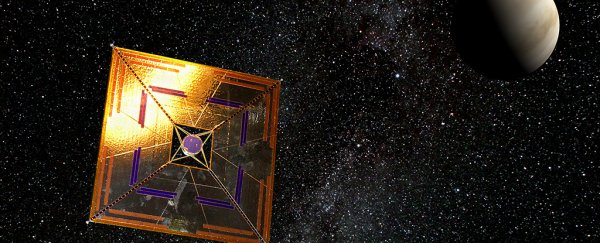If humans are going to send tiny probes across the vast distances of space, the designs of their sails will need to strike a delicate balance of mass, strength, and reflectivity. Now engineers have invented a nanomaterial that might just do the trick, helping us push space probes closer to light speed.
The new material, invented by engineers from the California Institute of Technology, is made out of silicon and its oxide, silica.
The team has worked out that super thin structures made of these two materials could convert waves of infrared light into a momentum that would accelerate a probe to speeds of around 60,000 kilometres (37,000 miles) per second.
That's an astonishing 20 percent of the speed of light, which could carry a small probe to our closest stellar neighbours, a huddle of stars called Proxima centauri, within decades rather than millennia.
It's in our nature to reach out and touch. While we know a lot about distant stars from the light they emit, we're driven to get ever closer for a better look.
Sending humans into a nearby solar system just isn't going to happen any time soon. But science might be within reach of using the inertia of photons to get tiny pieces of tech up to the velocities required to cover big distances in relatively short amounts of time.
Unlike chunky air molecules, light doesn't have a resting mass. So it doesn't 'blow' in the same way wind does. But flying photons still pack a punch by exerting pressure via their momentum, according to Maxwell's equations on electromagnetic radiation.
The idea is to use a laser to coherently shoot a stream of photons at infrared wavelengths at a 'light net', or sail, attached to an object we want to transport through space.
Even for small objects that would mean casting a big sail, which in turn means adding more mass. So this sail needs to be as light as possible, which could make it prone to easy damage.
Already you can see the problems begin to mount.
Then there is the question of heat. Photons impacting the molecules making up this light-harvesting net would be absorbed, making them jiggle with added energy.
So the perfect material would need to be able to handle the high temperatures by quickly shedding that heat as radiation.
Most contending materials, such as aluminium and graphene, have problems with the way they catch or emit light, or are too heavy, or too weak.
By turning to nanomaterials, engineers have the advantage of tweaking the way light is absorbed and emitted, allowing them to fine-tune the delicate balance of catching enough light to build up speed without overheating.
A super thin layer made of silicon and silicon dioxide – or silica – could be just what we need.
The silicon component would have the right refractive index, a measure of the way light hits and is re-emitted. That gives the sail the push it needs to build up speed.
But silicon isn't very good at emitting heat as radiation, so would risk disintegrating.
Silica doesn't share silicon's talent for refraction. But it does convert heat energy into radiation more efficiently than silicon on its own, providing for better cooling.
Whether or not this precise recipe proves to be optimal requires experimentation.
But the team also came up with a new standard we can use to test the efficiency of potential sails as a measure of their reflectivity versus payload mass, called a reflectivity adjusted area density, or RAAD.
Using this measure, we can compare the reflectivity of different materials and get a better estimate on their potential velocities.
Time will tell if a mix of silica and silicon will perform as hoped. Even if it does, there are still plenty of challenges ahead before we can expect postcards from outside our Solar System.
IKAROS, a solar-sail driven craft launched by the Japan Aerospace Exploration Agency in May, 2010, had sails made out of an imide polymer.
It managed an impressive speed of around 100 metres per second – fast enough to get to Venus by December the same year, but nowhere near fast enough for interstellar travel.
Still, it shows we're on our way.
With this kind of research, it's possible those challenges could continue to shrink in coming years. Those stars just might be within reach yet.
This research was published in Nano Letters.
